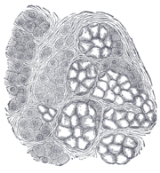
Submandibular gland
Overview
Salivary gland
The salivary glands in mammals are exocrine glands, glands with ducts, that produce saliva. They also secrete amylase, an enzyme that breaks down starch into maltose...
s located beneath the floor of the mouth. In humans, they account for 70% of the saliva
Saliva
Saliva , referred to in various contexts as spit, spittle, drivel, drool, or slobber, is the watery substance produced in the mouths of humans and most other animals. Saliva is a component of oral fluid. In mammals, saliva is produced in and secreted from the three pairs of major salivary glands,...
ry volume and weigh about 15 grams. Unstimulated (at rest) in humans, the percentage contribution to whole saliva; ~25% Parotid, Submandibular and Sublingual ~ 67% and ~8% minor mucous glands. During stimulated secretion the parotid gland produces majority of the saliva.
Lying superior to the digastric muscle
Digastric muscle
The digastric muscle is a small muscle located under the jaw. so digastric muscles are muscle fibers in ligament of treitz ,omohyoid , occipitofrontalis....
s, each submandibular gland is divided into superficial and deep lobes, which are separated by the mylohyoid muscle
Mylohyoid muscle
The mylohyoid muscle is a muscle running from the mandible to the hyoid bone, forming the floor of the oral cavity. It is named for its two attachments, with the prefix "mylo" coming from the Greek word for "molar". These muscles are mesodermal in origin...
:
- The deep portion is the smaller portion.

